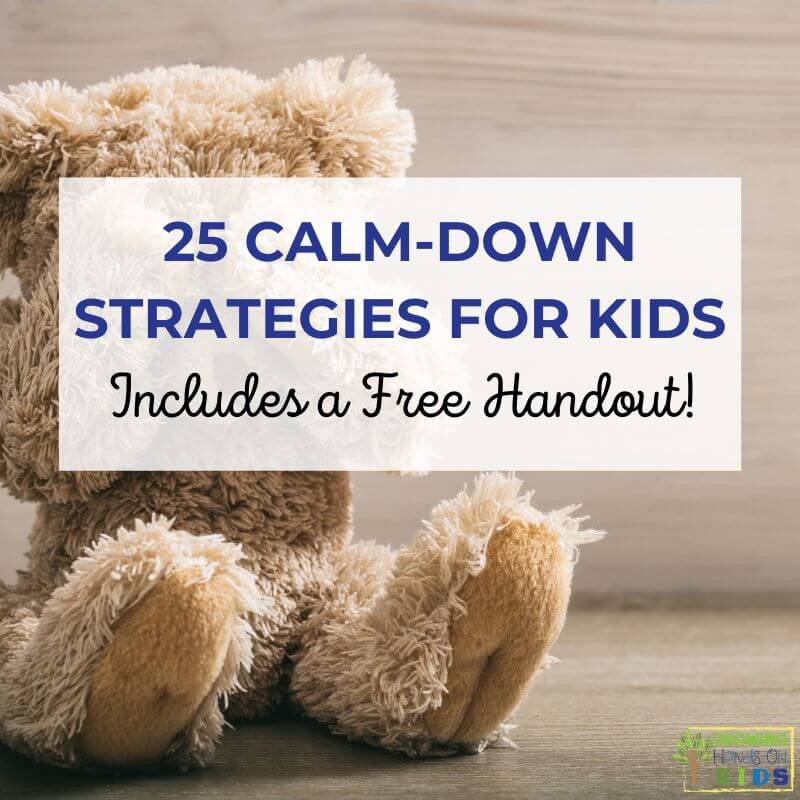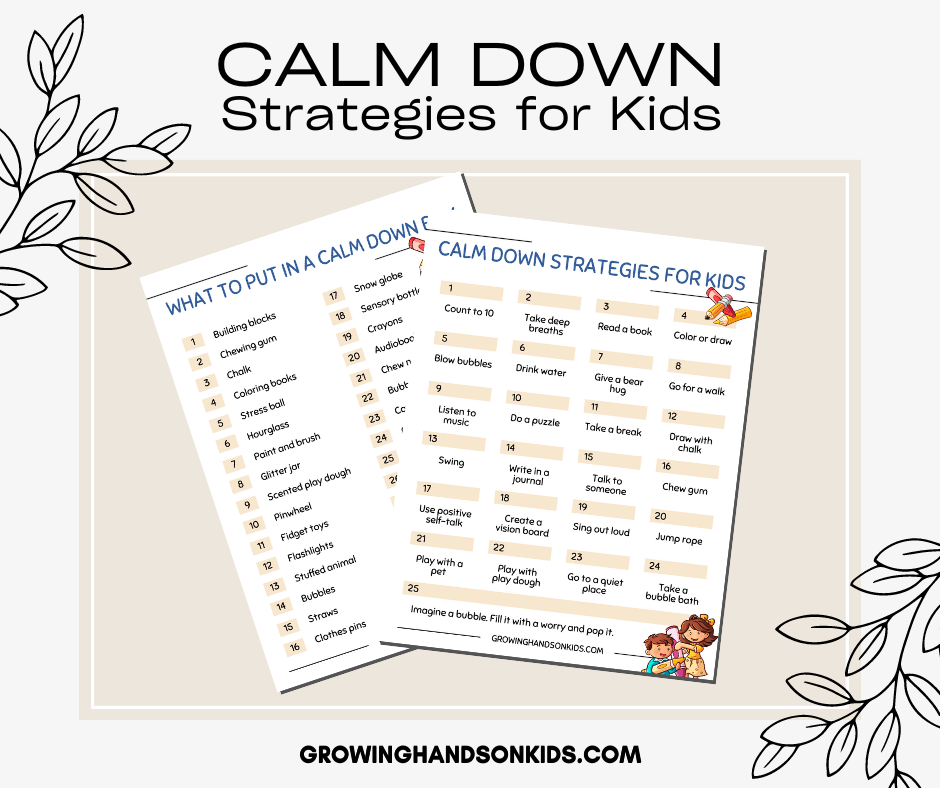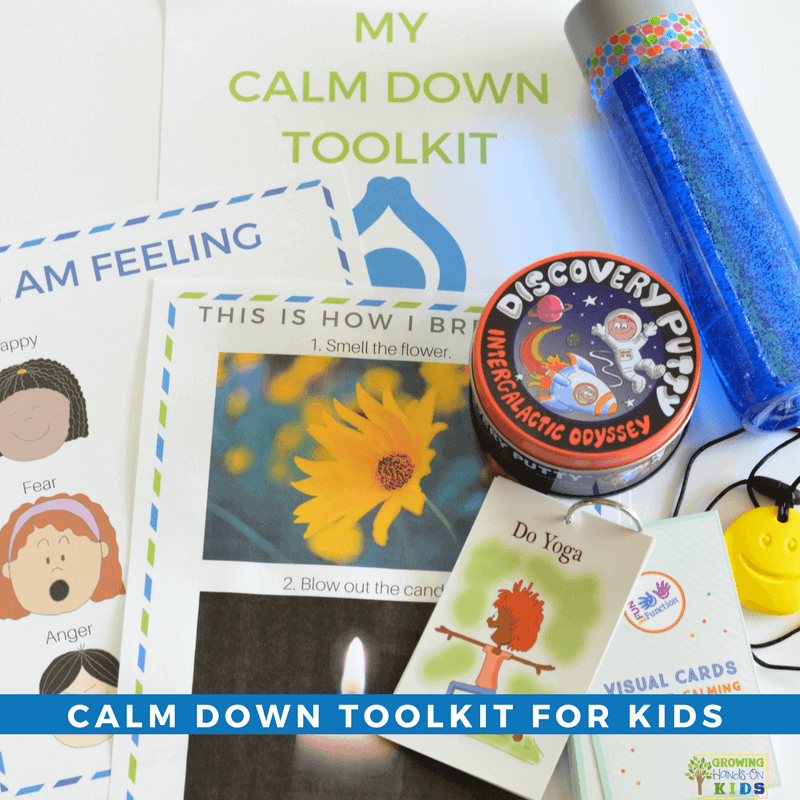25 Calm-Down Strategies for Kids – Free Download!
Affiliate and Referral links are used below to promote products I love and recommend. I receive a commission on any purchases made through these links. Please see my disclosure policy for more details. As an Amazon Associate, I earn from qualifying purchases.
It's OK to feel angry or stressed out sometimes, but how can you calm down when you're a child? Calm-down strategies can be part of the solution and I have some ideas to help get you started.
Be sure to keep reading this post to find some more tips on how to use calming strategies much more effectively.
There is also a free handout that you can print out with these calm-down strategies. Scroll down to the bottom of this post to sign-up to get the free download.
25 Calming Strategies for Kids
It's always a good idea to have a list of ideas to pull from. Some children will respond better to certain activities than others. And depending on the stressor or situation, some calming strategies may be easier to implement than others.
Also, giving children a choice will help them with self-regulation, when they can take ownership over how to help their body “calm down”.
Here are some ideas to help get you started:
1 || Count to 10
2 || Take deep breaths
3 || Read a book
4 || Color or draw
5 || Blow bubbles
6 || Drink water
7 || Give a bear hug
8 || Go for a walk
9 || Listen to music
10 || Do a puzzle
11 || Take a break
12 || Draw with chalk
13 || Swing
14 || Write in a journal
15 || Talk to someone
16 || Chew gum
17 || Use positive self-talk
18 || Create a vision board
19 || Sing out loud
20 || Jump rope
21 || Play with a pet
22 || Play with play dough
23 || Go to a quiet place
24 || Take a bubble bath
25 || Imagine a bubble. Fill it with a worry and pop it.
What are calm-down strategies?
Calm-down activities are a way to help bring the nervous system that is in a fight, flight or flee mode back into homeostasis, or a resting state.
“When kids are overwhelmed by feelings, the emotional side of the brain isn’t communicating with the rational side, which normally regulates emotions and plans the best way to deal with a situation.” (Giller, ChildMind).
Using these activities helps to relax the brain and encourage a child, or adult, to the place of realizing they are not in danger.
In order for calm-down strategies (or emotional regulation strategies) to work, we must first focus on relationships and co-regulate with the child.
It also includes setting up the environment for success with consistent routines and places for a child to practice self-regulation, or to use during times of dysregulation.
What are effective calming strategies?
Calming strategies are ones that will help a child come out of dysregulation and enter back into regulation. Many calming activities include heavy work or “proprioceptive input”, which can have a calming effect on many children.
What is proprioceptive input? It is input through the muscles and joints that helps us to know where our bodies are and how they are moving. You can read more about proprioceptive input in my post here.
It is important to note that some proprioceptive activities may have an alerting effect on a child. If your child is already in a state of high alert due to dysregulation, then it is important to find proprioceptive input and activities that have a calming effect on them. It is not a one-size-fits-all scenario. It will take some time, patience, and trial and error to find the best activities.
And the types of activities that work one time may not be as effective the next time. This is why it is a good idea to have a list of activities to pull from.
Things like breathing exercises, mindfulness, meditation, and other relaxation techniques can also help a child feel more in control of the situation. Plus, these activities can help improve their mood and be an effective way to de-escalate meltdowns and tantrums.
When to Use Calm-Down Strategies
These types of activities are helpful for children who may be dealing with anxiety, trauma, tension, or upset by a change in the environment or transitions. What is great about calming strategies is that they can be used at home, in the classroom, or even out in different situations in the community.
These triggers can build up over the day, so the stress response you are seeing right now may be from something that happened at home, something that happened earlier in the day, or even the day before.
Keeping a trigger log along with what types of calm-down strategies seem to be helpful after dysregulation can be helpful for you to find common triggers. Then you can build your self-regulation routines and environment to help support that child or student when you know a trigger is likely.
This, of course, does not mean you can plan for all triggers or dysregulation. But it does give you tools that you can pull from and give you a head start to helping your child or student self-regulate.
Calm-Down Strategies Free Download
Subscribe to Growing Hands-On Kids for my weekly newsletter and get a free printable of the Calm-Down Strategies as a free gift. It is two pages and also includes a page of types of items you can include in a calm-down box or space in your home or classroom.
When you subscribe to my email list, you'll also be the first to know about new printables or products I create and products I recommend.
If you have already subscribed to GHOK, don't worry, you aren't actually subscribing again. Entering your email below just lets my email service provider know which printable download to send you. You will not receive duplicate emails from me in the future.
References:
Cave, M. (2022). Creating Calm: 5 Ways to Prevent Big Behaviors. PBIS Apps. https://www.pbisapps.org/articles/creating-calm-5-ways-to-prevent-big-behaviors
Fletcher, J. Evidence-based ways to calm down. Medical News Today (2019). https://www.medicalnewstoday.com/articles/326453
Lee, L. (2020). With Stress in Schools Increasing, Simple Strategies to Stay Calm. Edutopia. https://www.edutopia.org/article/stress-schools-increasing-simple-strategies-stay-calm/
Lovino EA, Koslouski JB, Chafouleas SM. Teaching Simple Strategies to Foster Emotional Well-Being. Front Psychol. 2021 Nov 10;12:772260. doi: 10.3389/fpsyg.2021.772260. PMID: 34858296; PMCID: PMC8631539.
Miller, C. How to Help Children Calm Down: Techniques for helping kids regulate their emotions and avoid explosive behavior. Child Mind Institute. https://childmind.org/article/how-to-help-children-calm-down/
Preventing Escalation in the Classroom. Safe Schools NOLA. Tulane University. https://safeschoolsnola.tulane.edu/safe-and-supportive-classrooms/preventing-escalation/
You May Also Like:

Heather Greutman, COTA
Heather Greutman is a Certified Occupational Therapy Assistant with experience in school-based OT services for preschool through high school. She uses her background to share child development tips, tools, and strategies for parents, educators, and therapists. She is the author of many ebooks including The Basics of Fine Motor Skills, and Basics of Pre-Writing Skills, and co-author of Sensory Processing Explained: A Handbook for Parents and Educators.



